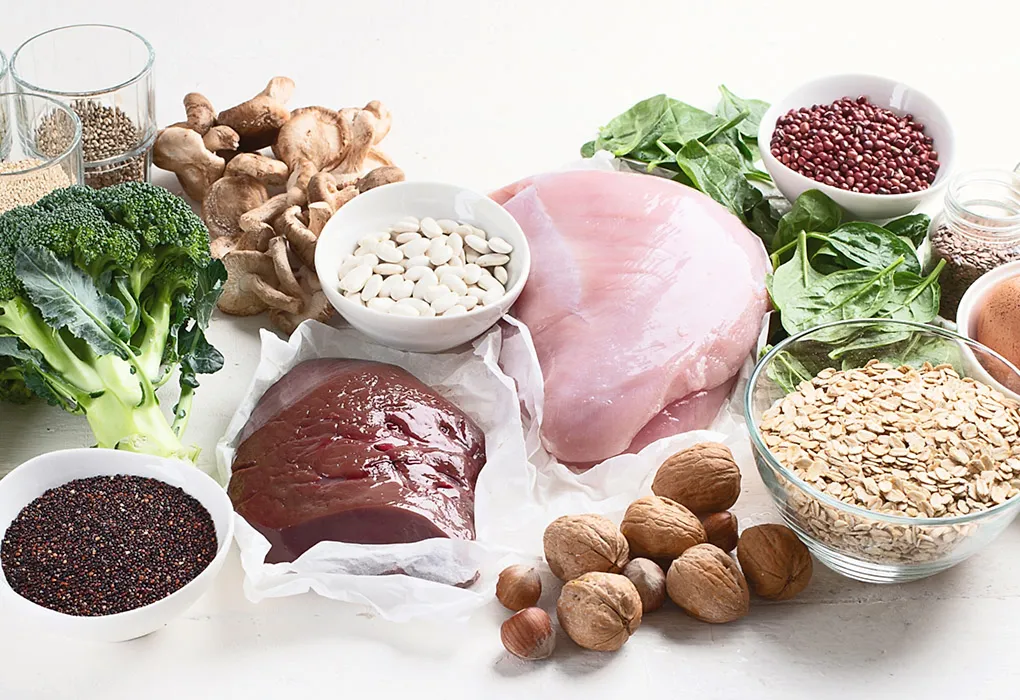Postpartum Anaemia – Causes, Symptoms & Treatments

- What Is Postpartum Anaemia?
- Is it Normal to Have Postpartum Anemia?
- What Causes Postnatal Anaemia
- Signs and Symptoms of Anaemia After Pregnancy
- Diagnosis of Postpartum Anemia
- Risk of Anaemia After Delivery
- Can Postpartum Anaemia Affect Breastfeeding?
- Tips to Treat Anaemia After Childbirth
- FAQs
Pregnancy and childbirth take a toll on women’s bodies. Recuperating, especially after childbirth, is essential for mothers to continue nursing their newborn babies. But, several mothers experience a new set of medical issues after delivering their babies. One of them is anaemia, a condition in which the haemoglobin count is lesser than normal.
Haemoglobin carries oxygen within the red blood cells. It requires iron, and a poor iron intake can cause anaemia. During childbirth, some women may bleed severely, and the condition can worsen if they are already anaemic. If you are an expecting parent, you will find this article pretty useful. Here, we have shared some essential information about postpartum anaemia, its causes, symptoms, and some tips for managing the condition.
What Is Postpartum Anaemia?
Post-delivery iron deficiency is called postpartum anemia. At one week postpartum, if the haemoglobin levels are less than 110 g/L, and at the 8th week, if the levels are at 120 g/L, then you have postpartum anaemia.
Stages of Anaemia
1. The First Stage
The iron content in the blood encounters a diminution due to the depletion of the iron levels in the bone marrow. You cannot notice any specific anaemic symptoms at this stage.
2. The Second Stage
You will start to notice some side effects of anaemia. The symptoms may include frequent headaches, and you may start feeling less active than you usually do each day. You can check for this deficiency through blood tests. The production of haemoglobin starts getting affected at this stage of anaemia.
3. The Third Stage
At this stage, anaemia is fully developed because the haemoglobin levels become so low. You will develop an unusual personality, feel extremely tired, and will be exhausted and sick.
Is it Normal to Have Postpartum Anemia?
Yes, postpartum anaemia is prevalent in women across the globe. The state of being anaemic after giving birth is more vividly seen in countries where the malnutrition index is higher.
What Causes Postnatal Anaemia
Postpartum anemia can be due to a number of factors. Here are some common postpartum anaemia causes to check out:
1. Poor Diet
If the iron taken during or before pregnancy is insufficient, then it leads to postpartum anaemia. When pregnant, make sure you take 4.4 mg of iron per day. You can take iron supplements before conception and during pregnancy because food does not contain enough amounts of iron. Even before conception, if you have heavy blood loss during menstruation, you may lose iron.
2. Peripartum Blood Loss
The iron reserves in the body deplete when there is a massive blood loss while giving birth. This can lead to anaemia after delivery. When blood loss is higher, the risk of developing anaemia is also greater. Low haemoglobin after delivery can cause anaemia.
3. Intestinal Diseases
Intestinal diseases like celiac disease, Crohn’s disease, and inflammatory bowel disease can affect the absorption of iron.
Signs and Symptoms of Anaemia After Pregnancy
The body will go through many changes when there is a massive drop in the levels of iron. After childbirth, you may experience specific postpartum anaemia symptoms, including the following:
- Extreme exhaustion and tiredness
- Pale skin
- Weakness
- Depression
- A sense of confusion
- Reduction in the quantity and quality of breast milk. This causes low weight gain in babies.
- Shortness of breath
- A feeling of dizziness
- Rapid heartbeat
- Frequent headaches
- Feeling of irritation
- Mood swings
- Reduction in sex drive
- An overall decrease in immunity
The symptoms of anaemia after childbirth may not necessarily be experienced all together at the same time. However, it is better to see your doctor if any of the above symptoms are unmanageable. This way, you can avoid many complications that might follow.
Diagnosis of Postpartum Anemia
The most common method for diagnosing anaemia involves a complete blood count test, which assesses the quantity, shape, and size of your blood cells using a blood sample.
For postpartum iron deficiency anaemia, experts typically diagnose through a full blood count, including tests for haemoglobin, serum ferritin, and serum soluble transferrin receptor. These tests are reliable indicators of anaemia and iron levels within a week after giving birth.
Risk of Anaemia After Delivery
Anaemia should be treated as early as possible to avoid several risks to the mothers. A few of these risks are:
- Concentration becomes poor.
- Completing everyday tasks becomes more difficult due to tiredness.
- Chances of premature birth increase, and the mother might face complications in consecutive pregnancies.
- Death due to extreme fatigue or other side effects.
New mothers are at risk of developing postpartum anaemia if they come under the categories given below:
- Deficiency of iron during or before pregnancy
- Several pregnancies
- Pre-pregnancy Body Mass Index over 24
- Caesarean delivery
- Insufficient recovery time between pregnancies
- Excessive bleeding when giving birth
- Premature delivery
- Placenta previa
- Hypertension
- Low income affecting the mother’s nutrition, and pre and postnatal medical expenses
- Subsequent births
The baby’s nourishment might also be affected if you experience some of these symptoms.
Can Postpartum Anaemia Affect Breastfeeding?
Anaemia radically decreases the immune function; it could cause problems if you have decided to breastfeed your baby. However, even moms who are not anaemic can face these issues.
A few of the common problems are clogged milk ducts, thrush, a longer healing time of the nipples, and mastitis. A decrease in the quantity and quality of the milk produced can also occur. It might bring down the duration of breastfeeding and could also lead to weaning at a very early age causing poor weight gain in babies. Babies become tougher to handle and may have trouble sleeping.
You can, however, work these out with the help of a lactation consultant. Your baby might not become anaemic even if you have anaemia because the chances are extremely low. Nevertheless, it is better to check with the paediatrician after six months, and he may start giving the baby iron supplements if necessary.
Tips to Treat Anaemia After Childbirth
You can treat postpartum anemia by changing your lifestyle and your diet. These nine tips on postpartum anaemia treatment will help to improve the condition.
1. Iron Supplements
You can improve the levels of iron in your blood by taking iron supplements. It is better to take tablets, capsules, or tonics recommended by your doctor.
2. Eating Food Rich in Iron
You can consume iron-rich foods like –
- Green leafy vegetables like spinach
- Beans, peas, lentils, and cereals
- Fruits like apricots, strawberries, squash, and pumpkins
- Iron-fortified bread
- Beef, oysters, and chicken

3. Reduce Tea Consumption
Tea contains tannin, an ingredient that slows down the absorption of iron in the human body. A high intake of calcium can also reduce iron absorption in the body.
4. Vitamin C
Taking food that is rich in vitamin C can help to raise the amount of iron absorbed in the body. Fruits are the highest source of vitamin C.

5. High Fluid Consumption
It is essential to stay hydrated during pregnancy because it helps to improve the blood flow after childbirth. Intake of fluids prevents blood from clotting and protects you from urinary tract infection. Fluid also helps to deal with bloating, which is caused by some iron supplements. Per day, it is best to drink around two litres because excessive intake of fluids may dilute the blood.
6. Stool Softeners
Constipation, which is a side effect of anaemia, can be dealt with stool softeners. You can also increase the consumption of fluid to prevent constipation.

7. Risk of Infection
Anaemia affects immunity and increases the risk of infection. Talk to your GP and OBGYN if you notice any symptoms of infection.
8. Resting Well
Due to decreased iron levels, you are more likely to feel very tired and exhausted. Getting enough rest during these times is vital.

9. Follow Up With Your Doctor
It is better to keep visiting a doctor if you are diagnosed with this condition. The doctor will take the essential steps based on the results of your blood work. He may also advise you to take injections or even a blood transfusion if the iron levels keep dropping.
FAQs
1. How Much Iron Should You Take After Giving Birth?
The Recommended Dietary Allowance for iron is 9 mg/day during lactation to prevent postnatal anaemia. This is based on the assumption that there will be no menstrual losses during the first 6 months after delivery, and the iron stored during prenatal of maternal red blood cells can be used, recycled likely, by the lactating mother.
2. Does Anaemia Lead to Postpartum Haemorrhage?
Pre-pregnancy anaemia can increase the chances of postpartum haemorrhage.
3. How Long Does Anaemia Last After Pregnancy?
There is no certain time set for the anaemia to last after pregnancy. Until iron deficiency is not eliminated by restoring the iron levels to bring the haemoglobin levels back to normal, the anaemia will last.
Speak with your doctor if you observe any unusual post-delivery symptoms. Also, maintain the levels of iron by improving your diet. A nutritionist will help you restore the lost nutrients post-delivery. If you manage anaemia, postpartum haemorrhage can also be avoided.
References/Resources:
1. Chung. M, Chan. J. A, Moorthy. D, et al.; Biomarkers for Assessing and Managing Iron Deficiency Anemia in Late-Stage Chronic Kidney Disease: Future Research Needs: Identification of Future Research Needs From Comparative Effectiveness Review No. 83; Rockville (MD): Agency for Healthcare Research and Quality (US); PubMed; https://www.ncbi.nlm.nih.gov/books/NBK143610/; January 2013
2. Milman. N; Postpartum anemia I: definition, prevalence, causes, and consequences; Ann Hematol.; PubMed; https://pubmed.ncbi.nlm.nih.gov/21710167/; November 2011
3. Mremi. A, Mlay. J, et al.; Prevalence of post-partum anemia and associated factors among women attending public primary health care facilities: An institutional based cross-sectional study; Plos One; https://journals.plos.org/plosone/article?id=10.1371/journal.pone.0263501; February 2022
4. Milman N; Postpartum anemia II: prevention and treatment; Ann Hematol.; PubMed; https://pubmed.ncbi.nlm.nih.gov/22160256/; February 2012
5. Foods high in iron; HealthDirect; https://www.healthdirect.gov.au/foods-high-in-iron
6. Markova. V, Norgaard. A, et al.; Treatment for women with iron deficiency anaemia after childbirth; Cochrane; https://www.cochrane.org/CD010861/PREG_treatment-women-iron-deficiency-anaemia-after-childbirth; August 2015
7. Jorgensen. J. M, Yang. Z, Lönnerdal. B, et al.; Effect of iron supplementation during lactation on maternal iron status and oxidative stress: A randomized controlled trial; Matern Child Nutr.; PubMed Central; https://www.ncbi.nlm.nih.gov/pmc/articles/PMC6866113/; October 2017
8. World Health Organization; Guideline: Iron Supplementation in Postpartum Women.; https://www.ncbi.nlm.nih.gov/books/NBK379991/; 2016
9. Saboor. M, Zehra. A, Qamar. K, Moinuddin; Disorders associated with malabsorption of iron: A critical review; Pak J Med Sci.; PubMed Central; https://www.ncbi.nlm.nih.gov/pmc/articles/PMC4744319/; November-December 2015
10. Milman. N; Iron in pregnancy: How do we secure an appropriate iron status in the mother and child?; Ann Nutr Metab.; PubMed; https://pubmed.ncbi.nlm.nih.gov/22123639/; 2011
11. Henly. S. J, Anderson. C. M, Avery. M. D, et al.; Anemia and insufficient milk in first-time mothers; Birth; https://pubmed.ncbi.nlm.nih.gov/7779228/; June 1995
12. Bardosono. S, Prasmusinto. D, et al.; Fluid Intake of Pregnant and Breastfeeding Women in Indonesia: A Cross-Sectional Survey with a Seven-Day Fluid Specific Record; Nutrients; PubMed Central; https://www.ncbi.nlm.nih.gov/pmc/articles/PMC5133054/; November 2016
Also Read:
Postpartum Cramps
Postpartum Psychosis
Postpartum Oedema
Common Postpartum Complications & Their Solutions
Was This Article Helpful?
Parenting is a huge responsibility, for you as a caregiver, but also for us as a parenting content platform. We understand that and take our responsibility of creating credible content seriously. FirstCry Parenting articles are written and published only after extensive research using factually sound references to deliver quality content that is accurate, validated by experts, and completely reliable. To understand how we go about creating content that is credible, read our editorial policy here.
























